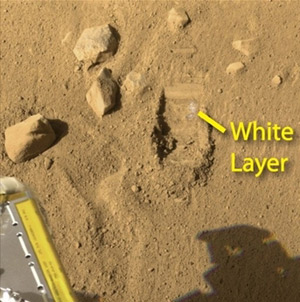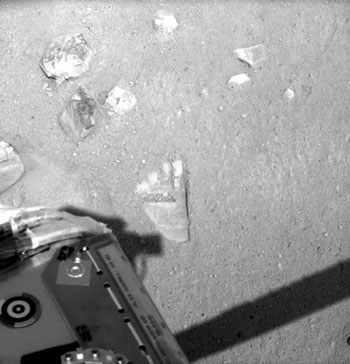News, June 2008
Archives
Mission & Name
Conflict Terminology
Editorials
Gaza Holocaust
Gulf War
Isdood
Islam
News
News Photos
Opinion Editorials
US Foreign Policy (Dr. El-Najjar's Articles)
www.aljazeerah.info
|
Editorial Note: The following news reports are summaries from original sources. They may also include corrections of Arabic names and political terminology. Comments are in parentheses. |
Phoenix lander gets close-up look at Mars dirt, delivers 1st soil sample to microscope
Phoenix lander gets close-up look at Mars dirt
www.chinaview.cn 2008-06-14 12:30:08
WASHINGTON, June 13 (Xinhua) --
New observations from NASA's Phoenix Mars Lander provided the most magnified view ever seen of Martian soil, showing particles clumping together even at the smallest visible scale, the mission science team reported on Friday.
In the past two days, two instruments on the lander deck -- a microscope and a bake-and-sniff analyzer -- have begun inspecting soil samples delivered by the scoop on Phoenix's Robotic Arm.
|
|
|
|||
|
|
|
Images from Phoenix's Optical Microscope showed nearly 1,000 separate soil particles, down to size smaller than one-tenth the diameter of a human hair. At least four distinct minerals are seen, the team said.
"I'm absolutely gobsmacked that we're now looking at the soil of Mars at a resolution that has never been seen before," said TomPike of Imperial College London, who is a Phoenix co-investigator working on the lander's Microscopy, Electrochemistry and Conductivity Analyzer.
The sample includes some larger, black, glassy particles as well as smaller reddish ones. "We may be looking at a history of the soil," said Pike. "It appears that original particles of volcanic glass have weathered down to smaller particles with higher concentration of iron."
The fine particles in the soil sample closely resemble particles of airborne dust examined earlier by the microscope.
"This is the first time since the Viking (Mars exploration) missions three decades ago that a sample is being studied inside an instrument on Mars," said Phoenix Principal Investigator Peter Smith on Friday.
Stickiness of the soil at the Phoenix landing site has presented not only challenges for delivering samples but also scientific opportunities.
"Understanding the soil is a major goal of this mission and the soil is a bit different than we expected," Smith said. "There could be real discoveries to come as we analyze this soil with our various instruments. We have just the right instruments for the job."
Editor: Jiang Yuxia
NASA's Mars lander delivers 1st soil sample to microscope
www.chinaview.cn 2008-06-13 07:25:10
 |
||
| A white layer visible where the Phoenix Lander robotic arm scooped away the martian soil. NASA said images received on Thursday confirmed that its Phoenix Mars lander has sprinkled a spoonful of Martian soil onto the sample wheel of the spacecraft’s robotic microscope station. (Xinhua/AFP Photo, 6/13/08). |
WASHINGTON, June 12 (Xinhua) --
NASA said images received on Thursday confirmed that its Phoenix Mars lander has sprinkled a spoonful of Martian soil onto the sample wheel of the spacecraft's robotic microscope station.
"It looks like a light dusting and that's just what we wanted," said Michael Hecht of NASA's Jet Propulsion Laboratory, who is the lead scientist for the Microscopy, Electrochemistry and Conductivity Analyzer (MECA) instrument on Phoenix.
The delivery of scooped-up soil for inspection by the lander's Optical Microscope, a component of MECA, marks the second success in consecutive days for getting samples delivered to laboratory instruments on Phoenix's deck.
Some soil from an earlier scoopful by the Robotic Arm reached a tiny oven in another instrument on Tuesday, as confirmed in data received early Wednesday. That instrument is the Thermal and Evolved-Gas Analyzer, or TEGA.
New commands being sent to Phoenix on Thursday include instructions to close the TEGA oven and begin analyzing the sample inside, a process that will take several days, NASA Phoenix team reported.
|
|
|
|
||
|
||||||



